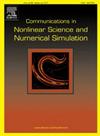Torsional vibration analysis and suppression for integrated electric drive system considering nonlinear excitations
IF 3.4
2区 数学
Q1 MATHEMATICS, APPLIED
Communications in Nonlinear Science and Numerical Simulation
Pub Date : 2025-02-17
DOI:10.1016/j.cnsns.2025.108695
引用次数: 0
Abstract
Integrated Electric Drive Systems (IEDS) are widely used in electric vehicles due to its compact design and high-power density. To address the issue where nonlinear excitations and variable, complex operating conditions of IEDS can exacerbate high and low-frequency torsional vibrations, leading to decreased reliability of the IEDS. The active dual-layer suppression method is proposed based on analyzing inherent properties and the influence of nonlinear excitations, including time-varying meshing stiffness, backlash, meshing error, and dead-zone, on the dynamic performance of IEDS, which can simultaneously suppress high and low-frequency torsional vibration of the IEDS. In the upper-layer, a torsional vibration suppression method based on pole placement is proposed to optimize the motor's reference torque. Then, a current harmonic suppression method based on active disturbance rejection control is proposed in the lower-ayer to compensate for the voltage errors caused by nonlinear excitations and decoupling errors, thereby reducing current harmonics and torque ripple. The simulation and experimental results show that the method can effectively reduce current harmonics and torque ripple, while also decreasing high and low frequency torsional vibrations of IEDS. This enhances the reliability of IEDS and improves the vehicle stability.
求助全文
约1分钟内获得全文
求助全文
来源期刊

Communications in Nonlinear Science and Numerical Simulation
MATHEMATICS, APPLIED-MATHEMATICS, INTERDISCIPLINARY APPLICATIONS
CiteScore
6.80
自引率
7.70%
发文量
378
审稿时长
78 days
期刊介绍:
The journal publishes original research findings on experimental observation, mathematical modeling, theoretical analysis and numerical simulation, for more accurate description, better prediction or novel application, of nonlinear phenomena in science and engineering. It offers a venue for researchers to make rapid exchange of ideas and techniques in nonlinear science and complexity.
The submission of manuscripts with cross-disciplinary approaches in nonlinear science and complexity is particularly encouraged.
Topics of interest:
Nonlinear differential or delay equations, Lie group analysis and asymptotic methods, Discontinuous systems, Fractals, Fractional calculus and dynamics, Nonlinear effects in quantum mechanics, Nonlinear stochastic processes, Experimental nonlinear science, Time-series and signal analysis, Computational methods and simulations in nonlinear science and engineering, Control of dynamical systems, Synchronization, Lyapunov analysis, High-dimensional chaos and turbulence, Chaos in Hamiltonian systems, Integrable systems and solitons, Collective behavior in many-body systems, Biological physics and networks, Nonlinear mechanical systems, Complex systems and complexity.
No length limitation for contributions is set, but only concisely written manuscripts are published. Brief papers are published on the basis of Rapid Communications. Discussions of previously published papers are welcome.
 求助内容:
求助内容: 应助结果提醒方式:
应助结果提醒方式:


